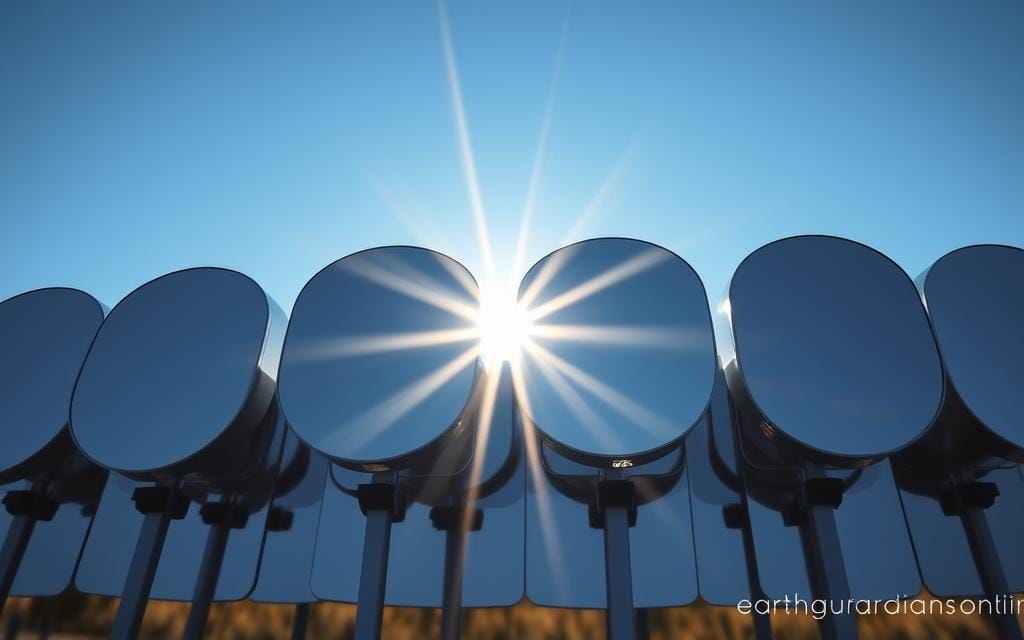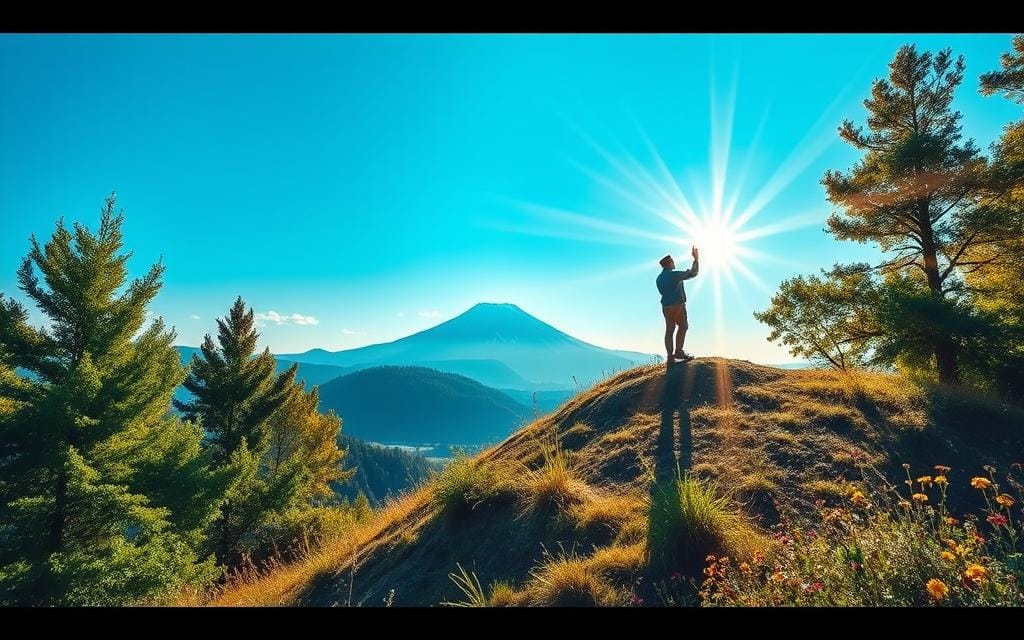In this guide, we’ll show you how to use reflected sunlight to signal someone. This method is key in survival situations or when you need to get attention fast. We’ll talk about why signaling is important, how sunlight works for this, what you need, and how to do it right. By the end, you’ll know how to use the sun’s light to alert others and maybe even save lives.
Table of Contents
ToggleImportance of Being Able to Alert Others in Emergencies
Alerting others in an emergency can save lives. If you’re lost or stranded, signaling for help can boost your rescue chances. Reflected sunlight is a great way to signal because it’s easy to do and you can use many materials.
Scenarios Where Alerting Someone Quickly Can Be Crucial
Being able to quickly alert others in emergencies is key. For example, if you’re lost in a remote area with no phone signal, signaling can save your life. Or, if you’re stranded after a car breakdown or disaster, alerting others fast can lead to a quicker rescue.
Advantages of Using Reflected Sunlight as a Signaling Method
- Visibility: Reflected sunlight makes a signal easy to see from far away, helping you get noticed.
- Ease of use: This method is simple and doesn’t need much gear, making it great for emergencies.
- Availability of materials: You can use mirrors or other shiny things you find, making it easy to signal.
Knowing how to signal for help with reflected sunlight can help you in emergencies. It’s a smart way to increase your chances of getting rescued.
Understanding the Principles of Reflected Sunlight
To use reflected sunlight for signaling, we need to understand how sunlight behaves on reflective surfaces. Knowing the science behind it helps us make a signal that’s easy to see.
When sunlight hits a shiny object, like a mirror or metal, it bounces back at the same angle it came in. This means the light hits and leaves the surface at the same angle. We can use this to aim our signal towards where we want it to be seen.
| Angle of Incidence | Angle of Reflection |
|---|---|
| 30 degrees | 30 degrees |
| 45 degrees | 45 degrees |
| 60 degrees | 60 degrees |
The strength of the reflected sunlight also depends on the material’s reflectiveness. Mirrors give a strong, focused reflection. But rough surfaces produce a weaker, more spread-out signal. Knowing this helps us pick the best material for our signals.
Understanding reflected sunlight lets us use it to make signals that are easy to see. This is very important in emergencies or when we need help.
Materials You’ll Need to Alert Someone With Reflected Sunlight
To alert someone using reflected sunlight, you’ll need a few key items. A compact mirror or other reflective surfaces like a metal spoon or foil back are essential. These tools help capture and direct sunlight, making a bright signal that can be seen far away.
Compact Mirrors or Other Reflective Surfaces
A compact mirror is perfect for signaling with sunlight. It lets you focus and direct the sunlight, making a strong flash. If you don’t have a mirror, use the back of a metal spoon or foil. These can also signal for help.
Optional: Signaling Devices for Enhanced Visibility
- Signal mirrors: These mirrors are made for signaling and make your message more visible.
- Signal flares: Adding flares can increase the chance of being seen, especially when it’s hard to see.
While a mirror or reflective surface is key, adding signal mirrors or flares can make your signal better. These items help make sure your message gets through, raising the chances of getting help.
| Material | Purpose | Advantages |
|---|---|---|
| Compact Mirror | Primary signaling tool | Concentrated, bright flashing signal |
| Metal Spoon or Foil | Improvised reflective surface | Readily available alternative to a mirror |
| Signal Mirror | Specialized signaling device | Increased visibility and range |
| Signal Flare | Supplementary signaling device | Attracts attention in low-visibility conditions |
How to Alert Someone With Reflected Sunlight
We’ll give you a step-by-step guide on using reflected sunlight to signal for help. You’ll learn how to angle the reflective surface, time your flashes, and make sure your signal is seen from afar.
Step-by-Step Guide for Effectively Using Sunlight Reflections
To signal someone with reflected sunlight, just follow these steps:
- Find a compact mirror or other highly reflective surface.
- Angle the reflective surface towards the sun to create a bright, focused beam of light.
- Aim the reflected light towards the area where you need to signal for help.
- Flash the light by quickly moving the reflective surface back and forth, creating a series of short, bright flashes.
- Time the flashes to create a recognizable pattern, such as the Morse code distress signal “SOS”.
Tips for Maximizing the Visibility of Your Signal
To make your signal as visible as possible, keep these tips in mind:
- Choose a reflective surface that is large enough to create a bright, focused beam of light.
- Coordinate with search and rescue teams to time your signaling with their search patterns.
- Use specific signaling patterns, such as Morse code, to clearly communicate your need for assistance.
- Vary the timing and intensity of your flashes to attract attention and stand out from natural sunlight reflections.
The key to using reflected sunlight to signal someone is to make a bright, visible signal. By following these steps and tips, you’ll be ready to signal for help in an emergency.
Techniques for Attracting Attention With Reflected Sunlight
We can do more than just flash a bright signal to get attention. We can use reflected sunlight to send out specific messages. This includes using Morse code or other signals to tell people where we are, if we need help, or other important info.
Morse Code and Other Signaling Methods
Using Morse code is a great way to signal for help with reflected sunlight. We flash the sunlight in short and long bursts to spell out letters and words. This method grabs attention and lets others know our situation and what we need.
We can also try other ways to use reflected sunlight to get noticed. We might make patterns, shapes, or symbols that mean something. Being creative with these methods can help us get the help we need.

It doesn’t matter which method we pick, the main thing is to make our signal stand out. By learning these techniques, we can greatly increase our chances of being seen and getting the help we need in an emergency.
Safety Precautions When Using Reflected Sunlight
Using reflected sunlight to signal can be very effective, but safety first is key. We’ll talk about risks like eye safety and how to signal safely. This way, you can use it without harm.
Protecting Your Eyes
When using reflected sunlight, eye safety is a big concern. The bright light can hurt your eyes, especially if it goes straight into someone’s eyes. Here’s how to stay safe:
- Avoid aiming the reflection directly into someone’s eyes.
- Use a compact mirror or other reflective surface that can be easily angled and controlled.
- Wear sunglasses or protective eyewear to shield your own eyes from the reflected light.
Minimizing Potential Distractions
Reflected sunlight can also distract or temporarily blind people, especially if they’re driving or using machinery. To keep everyone safe, think about the area and adjust how you signal:
- Avoid signaling in areas with heavy traffic or near critical infrastructure.
- Use the reflection intermittently, rather than maintaining a constant beam of light.
- Coordinate with nearby authorities or emergency responders, if possible, to ensure your signaling does not interfere with their operations.
| Safety Precaution | Description |
|---|---|
| Avoid Direct Eye Contact | Ensure the reflection is not aimed directly into someone’s eyes, as it can cause temporary blindness and eye damage. |
| Use Controlled Signaling | Employ intermittent or brief signaling rather than maintaining a constant beam of light to minimize distractions. |
| Coordinate with Authorities | Inform local authorities or emergency responders about your signaling activities to avoid interfering with their operations. |
By following these safety tips, you can signal with reflected sunlight safely. This keeps you and others around you safe.
Practicing and Mastering the Skill of Alerting With Reflected Sunlight
Becoming good at alerting someone with reflected sunlight takes practice and dedication. We’ll share tips and techniques to help you get better in different lighting conditions. These will improve your accuracy and how far you can signal.
Understanding how light works with different surfaces is key. Try using mirrors or shiny objects to see how they reflect sunlight. Work on making a focused beam that you can aim at your target.
- Start by practicing in open, well-lit areas where you can clearly see your target.
- Then, try signaling from farther away in various lighting conditions, like bright sunlight or cloudy skies.
- Work on a consistent way to hold the reflective surface, control the angle, and keep the beam steady.
Being accurate is important when signaling with reflected sunlight. Get better at lining up the reflection and try different hand and arm movements. This will help you control the beam and get attention.
The distance your signal can reach depends on your reflective surface size, sunlight intensity, and how far your target is. Keep working on making your signals stronger and farther reaching by improving your technique and using better equipment.
Practice regularly, be open to trying new things, and be willing to learn. This is how you master the skill of alerting someone with reflected sunlight. Embrace the challenge and feel proud when you get really good at it.
Alternative Methods for Signaling When Sunlight Is Not Available
Reflected sunlight is a great way to signal for help, but not always possible. We’ll look at other ways to signal when sunlight is not an option. This ensures you have many tools to get attention in emergencies.
Whistles and Horns
Whistles and horns are great for getting attention when it’s dark or hard to see. They make loud sounds that can go far, perfect for signaling in tough conditions or when you need help.
Flashing Lights
Flashing lights like LED flashlights or emergency strobes can replace reflected sunlight. They’re super bright, even in bad light, and can be seen far away.
| Signaling Method | Visibility Range | Durability | Ease of Use |
|---|---|---|---|
| Whistles and Horns | Up to 1 mile | High | Easy |
| Flashing Lights | Up to 0.5 miles | Moderate | Moderate |
| Smoke Signals | Up to 5 miles | Low | Moderate |
Smoke Signals
Smoke signals work well when you can see for miles. By making smoke, you can show where you are and need help, even without sunlight.
These other methods are useful for signaling in emergencies, but each has its own pros and cons. Think about the situation and pick the best way to signal.
Real-Life Examples and Success Stories
We’ll share real-life examples and success stories of using reflected sunlight to signal for help. This technique has saved lives and attracted attention in emergency situations. These stories will give you valuable insights and inspiration for this crucial survival skill.
A group of hikers got stranded in a remote area. They didn’t have a way to call for help, so they used a mirror to reflect sunlight. They kept flashing the light until a search and rescue helicopter spotted them and came to their rescue.
Another story is about a pilot who crashed in a dense forest. The pilot was injured and couldn’t move. They used a small mirror to reflect sunlight and catch the eye of a passing plane. Thanks to their persistence and the visible light, they were found and saved.
These stories show how powerful reflected sunlight can be for signaling. By learning this technique, people in tough situations can increase their chances of being seen and getting the help they need. These stories prove that this survival skill can be a lifesaver.
| Scenario | Outcome |
|---|---|
| Stranded hikers in remote mountains | Rescued by search and rescue helicopter |
| Downed pilot in dense forest | Successful search and rescue operation |
These stories show how reflected sunlight can save lives in emergencies. By learning how to use this method, you can quickly and effectively call for help in a crisis. Remember, knowing how to signal with reflected sunlight can be a key survival skill, offering a reliable way to get attention.
Conclusion
Being able to signal for help with reflected sunlight is a key survival skill. It can mean the difference between life and death in an emergency. By learning the basics, practicing, and getting better at it, we can signal for help and boost our rescue chances.
This article covered why signaling for help is crucial, the science behind sunlight reflection, what gear you need, and how to do it step by step. It also talked about safety and practicing your skills. Knowing how to use sunlight to signal can save your life, whether you’re lost in the wild or in a city emergency.
This method is great when other ways to call for help don’t work. By getting good at sunlight signaling, we can get spotted and get the help we need. This boosts our safety and chances of survival. So, practice this skill and be ready for any future challenges.
FAQ
What is the purpose of using reflected sunlight to alert someone?
Using reflected sunlight is a key survival skill in emergencies. It helps you quickly get attention and boost your rescue chances. This is especially useful when you’re lost, stranded, or in a hard-to-reach spot.
What materials do I need to create a sunlight reflection signal?
You’ll need a compact mirror or a shiny surface like the back of a metal spoon or foil. These can catch and direct sunlight, making a bright signal.
How do I effectively use reflected sunlight to alert someone?
To signal with reflected sunlight, do the following: 1) Angle the shiny surface to catch sunlight and aim it at your target. 2) Time your flashes to make a clear signal. 3) Use signals like Morse code to send important info.
Are there any safety considerations when using reflected sunlight?
Yes, safety is key when using reflected sunlight. Make sure not to shine the sunlight at people’s eyes. Always use the method safely and responsibly.
What are some alternative signaling methods if sunlight is not available?
If you can’t use sunlight, try making smoke signals, using signal flares, or making big symbols on the ground. Having different signals in your emergency kit is smart.









